WWII GERMAN CLOSE COMBAT BADGE - BRONZE -
This is a German WWII Close Combat clasp. This award was instituted on November 25th, 1942. There were three grades
issued; Bronze, Silver and Gold. The physical appearance of the the badges was identical from class to class. The
only difference was the color. Requirements for receiving the award of the Close Combat badge are listed below.
|
1. Soldier engaged in hand to hand combat while supported by armor. |
2. Bronze badge - Fifteen days of close combat. Reduced to ten days if the soldier is wounded. |
3. Silver badge - Thirty days of close combat. reduced to twenty if the soldier is wounded. |
4. Gold badge - Serving fifty days in close combat. Reduced to forty days if soldier is wounded. |
5. Russian front (1941) - Five close combat days represent eight months of service. |
6. Russian front (1941) - Ten close combat days represent twelve months of service. |
7. Russian front (1941) - Fifteen close combat days represent fifteen months of service. |
|
|
Several manufacturers produced this badge and it was distributed in large quantities, making it one of the most
common and readily available awards of the Third Reich. However, this has not proven to be a deterrent to the makers
of reproductions. There are a lot of fakes out in the market.
|
Hitler had an affinity for the Close Combat badge. He was instrumental in the development of the award.
In the early days he reserved the right of awarding himself the gold class badge to any soldier who earned it.
The first set of awards issued by Hitler took place on August 27th 1944, where he gave them to fourteen members
of the Waffen SS and army.
|
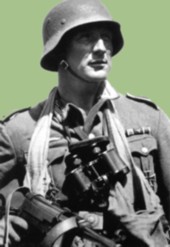 |
The Close Combat clasp was worn on the left breast of the
tunic,
above the ribbons. This sample is nicely marked with raised lettering.
The badge was designed by Ernst Wilhelm Peckhause. He was an artist from the city of Berlin.
By the end of the war a total of 403 Gold Close Combat badges were issued to armed forces personnel.
|
Close Combat Badge design
The shape of the badge is long and thin. The center is a square that has a single, long laurel leaves shooting out to
the left and the right. Each leaf then splits into three at the tip. To the top and bottom of the single leaf there
is what appears to be part of a square structure with seevral grooves cut into the surface and facing the away from the
center.
The center portion of the badge has a crossed
K98 bayonet
and
stick grenade .
A small eagle clutiching a swastika sits on top of both pieces. The background is a completly separate piece.
A black square that provides a 3-D look to the center of the badge.
|
This page is a recognition and identification guide for WWII German badges and awards. Multiple
detailed photos of a specific sample are provided. Descriptions point out clearly defined points
that should be noted.
One of the most commonly asked questions is "How much is my WWII German badge worth?". A price
guide is included here to address this question. The value of the badges and awards is reviewed
over a period of several years. A trend can be observed. The present worth of the German
badges in the collector's market is illustrated.
This service is provided free of charge to the visitor/enthusiast courtesy of
MilitaryItems.com,
a company dedicated to the preservation of military history and to providing quality military
antiques and collectibles to museums, institutions and the general public.
|
|



|
The "Military minute" is a series of instructional videos created by MilitaryItems.com for the purpose of
providing basic information about military collectibles. The idea is to expose people to the exciting
world of military collectibles.
The video presentation coupled with detailed photographs and written information, including a military
collectible's price guide, and anatomical breakdown of each piece enhances the visitor's experience.
Whether you are a long time collector, a beginner or simply have an interest in the history and value of
each collectible, we hope that you find the information presented here useful.
|
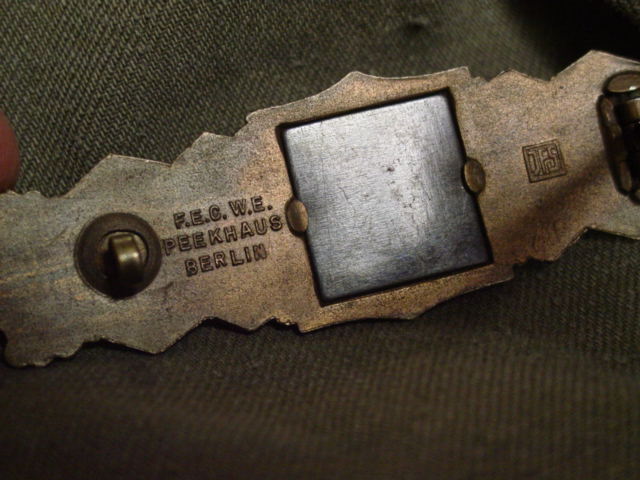
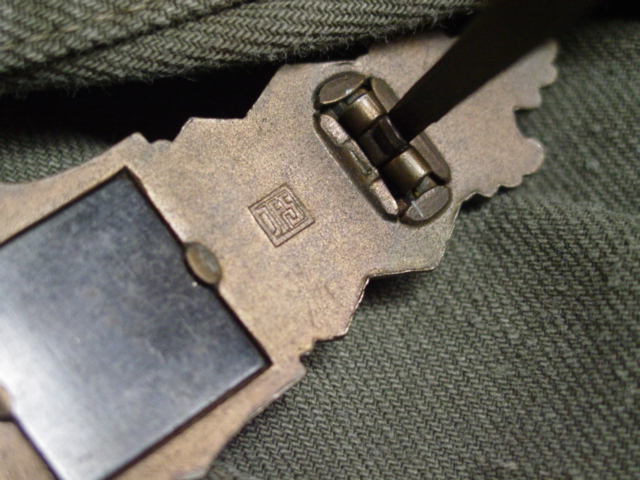
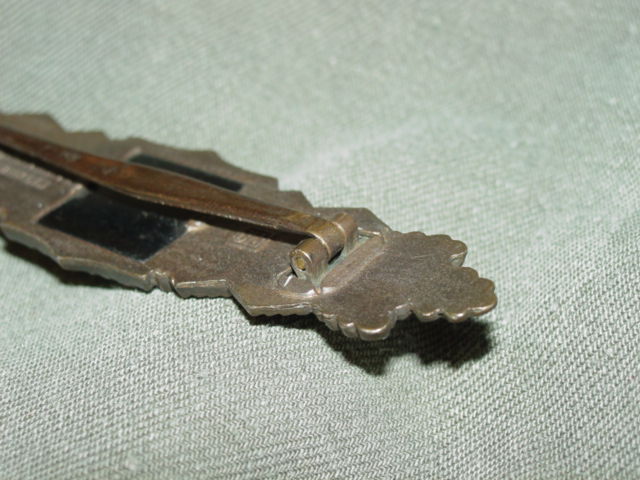
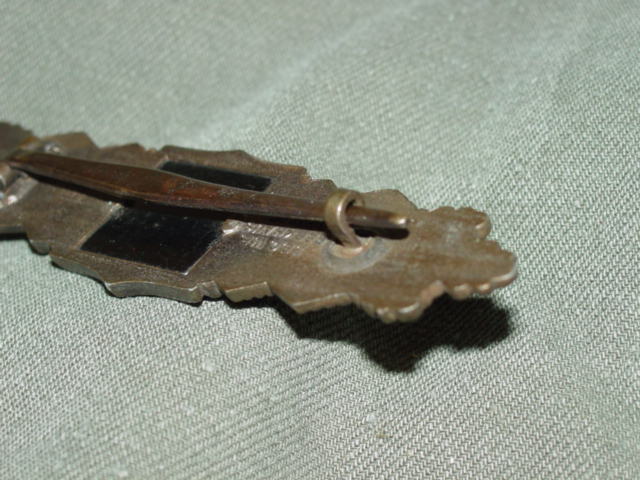
The German WWII Close Combat badge physical properties
The physical properties of a badge are a very important aspect to consider when determining
the authenticity of a badge. The information provided here covers the badge shown on this
page. It is important to note that there are variations among manufacturers.
The measurements shown here apply to the badge made by the JFS company.

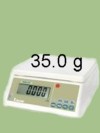
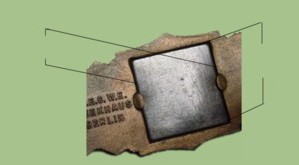

Becoming familiarized with the physical properties of the badge are key to become knowledgeable regarding
German awards. Learn the way in which each badge is put together. Pay attention to the construction
materials.
By the Numbers
It is hard to determine the exact number of Close Combat bages that were produced. However, thanks to the record
keeping maintained by the Wehrmacht, it is possible to find how many shields were actually issued.
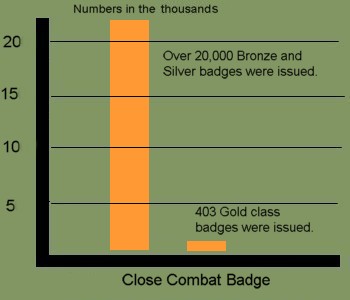 |
There were over 20,000 Bronze and Silver Close Combat badges issued during the war.
Only 403 Gold class were issued.
The Close Combat badge was issued along with an award document. Not all documents were identical. variations can
be found from unit to unit. A few things that all documents would have in common are the signature of the
officer who awarded the shield and the state seal.
|
|
Collecting Third Reich Badges
Collecting Third Reich memorabilia is a field that has been growing since the days the GI's rummaged around Europe
bringing back military souvenirs. German soldiers wore many of their awards on their uniforms when they went to battle.
Once the soldier was killed or captured, the American soldiers would take the awards as war trophies. Eventually all
these pieces came back to the United States where military history enthusiasts began to collect them.
|
"I am trying to figure out if I should get into collecting Close Combat badges."
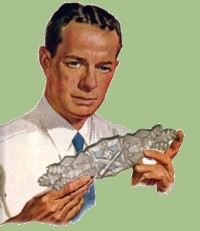
|
|
Determining which military badges to collect can be a challenging decision. The combination of availabiilty and
cost will often set the pace of what can be collected.
The adjacent table outlines some of the advantages and disadvantages of collecting the Close Combat badge.
|
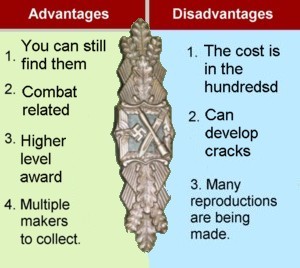 |
|
|







